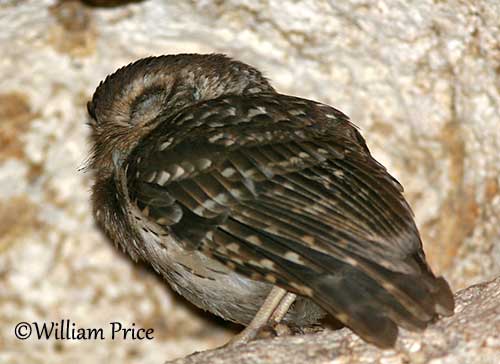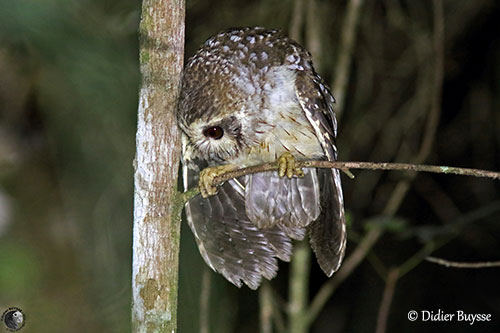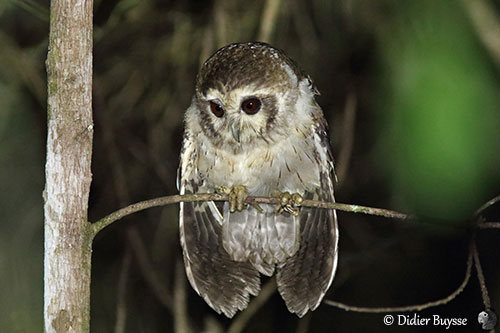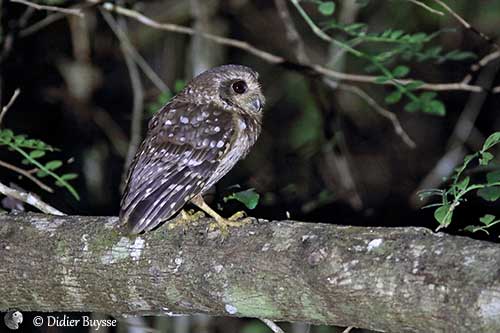
Fr: Petit-duc de Cuba
Ang: Bare-legged Owl
All: Kubaeule
Esp: Autillo Cubano
Ita: Assiolo zampenude
Nd: Cubaanse Schreeuwuil
Sd: kubauggla
Photographers:
Didier Buysse
Vision d’Oiseaux
Ken Havard
My Bird Gallery & Flickr gallery 1 & Flickr gallery 2
William Price
PBase-tereksandpiper & Flickr William Price
Text by Nicole Bouglouan
Sources :
HANDBOOK OF THE BIRDS OF THE WORLD Vol 5 by Josep del Hoyo-Andrew Elliott-Jordi Sargatal - Lynx Edicions - ISBN: 8487334253
BIRDS OF THE WEST INDIES – by Herbert Raffaele, Kristin Williams et Tracy Pedersen – Helm – ISBN: 9780713649055
OWLS OF THE WORLD – By Claus König, Friedhelm Weick and Jan-Hendrik Becking - IBSN 978-0-7136-6548-2
Neotropical Birds – Cornell Lab of Ornithology
Bare-legged Owl
Margarobyas lawrencii
Strigiformes Order – Strigidae Family
INTRODUCTION:
The Bare-legged Owl is endemic to Cuba and now classified in the monotypic genus Margarobyas, after wandering through other genera such as Otus and Gymnoglaux. It differs from these owls by lacking the ear-tufts and by its long bare legs, making it fairly similar to the Burrowing Owl.
It usually frequents forest and wooded areas with palm trees. It roosts and nests in tree holes and other natural cavities. It has nocturnal habits like numerous Strigidae.

DESCRIPTION OF THE BIRD:
Biometrics:
Length: 20-23 cm
Weight: 84-110 g
The Bare-legged Owl has brown to rufous upperparts with black and white spots. Mantle’s feathers have whitish tips and dark centres.
On the upperwing, some small whitish areas on scapulars form a very indistinct row of white spots across the shoulders. The wing-coverts are tipped white with dark centres. On the primaries, the outer webs are spotted white, but the inner webs are brownish. The secondaries are narrowly barred whitish.
The tail is relatively long with only ten feathers. The outer rectrices show narrow whitish bars, whereas the central feathers are uniformly brown-coloured.
The underparts are creamy-white with buff wash on breast and dark shaft streaks.

On the head, the facial disk is whitish-buff with a broad dark rim. We can see conspicuous, long, white eyebrows. Neck and throat are tinged buffy brown with fine black spots.
The hooked bill is yellowish-grey. The eyes are brown. Long tarsi and toes are bare and dull yellowish, almost greenish. The sharp claws are horn-coloured with black tips.
Male and female are similar.
The juvenile is mostly reddish-brown (sienna) above and on the breast, with paler belly.
SUBSPECIES AND RANGE:
The Bare-legged Owl has two subspecies.
M.l. lawrencii is found in central and eastern Cuba.
M.l. exsul occurs in W Cuba and Isle of Pines (or Isle of Youth).
The species is rare on Cayo Romano and Cayo Coco, and probably on Guajaba and Sabinal Peninsula.
HABITAT:
The Bare-legged Owl frequents woodlands and large tree plantations, mixed-forest with palm tree, thickets and semi-open limestone country where it can find caves and crevices for nesting.
The female lays two white eggs and incubates alone. She is probably fed by its mate during this period. At hatching, the chicks have whitish down.
The pair often returns to the same site in several following years.
PROTECTION / THREATS / STATUS:
The Bare-legged Owl is fairly common on Cuba and Isle of Pines. However, it is rare on the nearby cays.
The population is currently stable, and this species is evaluated as least Concern.
Most species are monogamous in the family Strigidae, and often with long-term pair-bonds. The behaviour of this species is unknown. We can suggest that the male sings at the beginning of the breeding season, and courtship feeding probably occurs too.
The Bare-legged Owl is endemic to Cuba and does not migrate.
It flies only over short distances, on short, rounded wings.
REPRODUCTION OF THIS SPECIES:
The breeding season takes place between January and June.
The Bare-legged Owl nests in cavities, usually holes in trees, cavities in broken tree limbs, or palms without foliage. It often uses abandoned woodpecker holes, and may nest in caves or rock crevices, usually in sheltered areas.

CALLS AND SONGS: SOUNDS BY XENO-CANTO
The Bare-legged Owl’s most typical call is a “coo-coo-coo-guguguk” usually higher-pitched towards the end. The female may respond with a harsh, plaintive scream, mostly descending “yiu-yiu-yiu”.
BEHAVIOUR IN THE WILD:
The Bare-legged Owl feeds primarily on large insects such as moths, but it also takes frogs and occasionally small birds.
It often hunts from perch and swoops down onto the prey as soon as it is located. But it frequently hunts on the ground too. It is strictly nocturnal.
The Bare-legged Owl roosts during the day, hidden in tree holes, caves or natural cavities. It often uses abandoned holes by woodpeckers.
They are usually seen in pairs. They remain in the forest canopy where they are often foraging.

